Recent Water Damage Posts
Protect Your Home: Exterior Maintenance Tips to Safeguard Against Water Intrusion
10/16/2024 (Permalink)
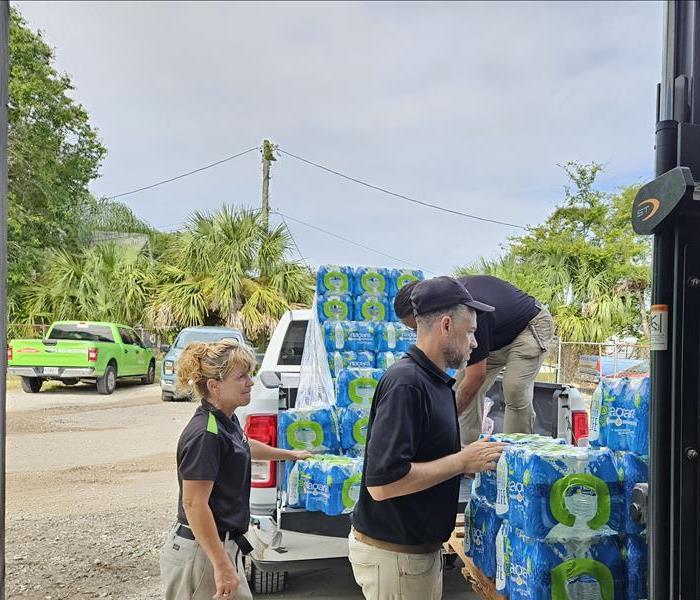 Here are key strategies to protect your property from water intrusion and ensure it remains safe and dry year-round.
Here are key strategies to protect your property from water intrusion and ensure it remains safe and dry year-round.
Water intrusion in Hillsborough, FL, is one of the most common threats to your home’s structural integrity. Left unchecked, it can cause extensive damage to your foundation, walls, and roofing. In fact, water damage accounts for nearly 14,000 home insurance claims every day in the U.S. Proper exterior maintenance is essential in preventing water from penetrating your home. Here are key strategies to protect your property from water intrusion and ensure it remains safe and dry year-round.
Inspect Your Roof Regularly
Your roof is your home's first line of defense against water intrusion. Small leaks can develop over time and lead to significant water damage if not addressed promptly. To protect your home:
- Inspect for Missing or Damaged Shingles: Check for any missing, cracked, or curling shingles and replace them immediately. Damaged shingles allow water to seep underneath and compromise the roof’s structure.
- Clean and Maintain Gutters: Clogged gutters can cause water to back up and pool near your roofline, leading to leaks and damage. Clean your gutters regularly, especially after heavy storms or the autumn season when leaves and debris are more likely to accumulate.
- Check Flashing: Ensure the flashing around your chimney, vents, and skylights is intact and properly sealed. Faulty flashing is a common source of leaks.
Seal Windows and Doors
Windows and doors are potential entry points for water if not properly sealed. Over time, the caulking and weather stripping around them can wear out, allowing water to penetrate your home. Here’s what you can do:
- Inspect Caulking: Regularly check the caulking around your windows and doors for cracks or gaps. Reapply caulk as needed to ensure a watertight seal.
- Replace Weather Stripping: Worn or damaged weather stripping should be replaced immediately. This is an inexpensive yet effective way to prevent water intrusion and improve your home’s energy efficiency.
Maintain Your Foundation
The foundation is critical in protecting your home from water damage. Improper drainage and cracks can allow water to seep into your basement or crawl space, leading to structural issues. To safeguard your foundation:
- Ensure Proper Grading: The ground around your home should slope away from the foundation to direct water away. A good rule of thumb is to have a slope of at least six inches for every 10 feet. If the grading is incorrect, regrading the landscape might be necessary.
- Inspect for Cracks: Regularly check your foundation for cracks, especially after severe weather. Small cracks can be sealed with waterproof masonry sealer, but larger cracks may require professional attention.
- Install a French Drain: If water tends to pool around your foundation, consider installing a French drain or other drainage systems to divert water away from your home.
Pay Attention to Siding and Exterior Walls
Your siding and exterior walls act as a barrier against the elements, but over time, they can become vulnerable to water penetration. Proper maintenance will help ensure they continue to protect your home effectively.
- Check for Damage: Inspect your siding for any cracks, holes, or loose panels. Water can easily find its way into even the smallest openings, so repair any damage immediately.
- Repaint or Reseal: Repainting or resealing your exterior walls can add an extra layer of protection against water. This is particularly important for wood siding, which is more prone to water damage than other materials.
Ensure Proper Drainage
Water pooling around your home can eventually find its way inside. Ensuring that your property has proper drainage is key to preventing water intrusion.
- Keep Gutters and Downspouts Clear: Regularly cleaning your gutters is crucial, but don't forget about your downspouts. Ensure they are clear of debris and direct water at least 10 feet away from your foundation.
- Consider Installing a Sump Pump: If your home is prone to water buildup, especially in the basement, a sump pump can help by automatically pumping water away from your home.
Conclusion
Preventing water intrusion starts with consistent exterior maintenance. By regularly inspecting and maintaining your roof, windows, doors, foundation, and drainage systems, you can protect your home from costly water damage. Staying proactive with these tips will help keep your home dry and secure, rain or shine.
For expert assistance with water damage restoration or if you need help protecting your home from water intrusion, trust SERVPRO® to be there for you. Whether you need emergency services or preventive maintenance, we’re just a call away.
By prioritizing these exterior maintenance tasks, you can safeguard your home against water intrusion and avoid the stress of unexpected repairs.
Top 5 Hidden Places You Might Find Mold
7/17/2024 (Permalink)
As a homeowner, discovering mold can be a daunting experience. Mold growth is not only unsightly, but it can also damage the integrity of your home. At SERVPRO®, we understand the importance of maintaining a mold-free environment, and we’re Here to Help® you identify the top five hidden places mold might be lurking in your home. By keeping an eye on these spots, you can catch mold early and take the necessary steps to eliminate it.
1. Behind Wallpaper and Drywall
One of the most common places mold hides is behind wallpaper and drywall. These areas can trap moisture from leaks or high humidity, providing the perfect environment for mold to thrive. If you notice any peeling wallpaper or discolored patches on your walls, it might be worth taking a closer look. Regularly inspect these areas, especially if you’ve recently experienced water damage.
2. Underneath Carpeting and Flooring
Mold can easily develop under carpets and flooring, especially if there’s been a spill or flooding that wasn’t thoroughly dried. Basements and bathrooms are particularly susceptible due to their higher humidity levels. To prevent mold growth, ensure that any spills are promptly cleaned up and that your floors are kept dry. Occasionally, check under your carpets and flooring for any signs of mold.
3. Inside HVAC Systems
Your HVAC system can be a hidden breeding ground for mold. The system's ducts and coils can accumulate dust and moisture, creating an ideal environment for mold spores to grow. Regular maintenance and cleaning of your HVAC system can prevent mold from spreading throughout your home. Change your filters regularly and have a professional inspect your system annually.
4. Behind Appliances
Appliances such as refrigerators, washing machines, and dishwashers are common culprits for hidden mold. These appliances can leak or produce condensation, leading to moisture build-up in hard-to-reach places. Pull these appliances away from the wall periodically to check for any signs of mold and clean the areas thoroughly. Regularly inspect the hoses and connections for leaks.
5. Inside Cabinets and Closets
Cabinets and closets, especially those in bathrooms and kitchens, can harbor mold due to their enclosed spaces and lack of ventilation. Leaky pipes or sinks can contribute to moisture build-up in these areas. Keep your cabinets and closets dry and well-ventilated by using moisture-absorbing products and periodically checking for leaks or signs of mold.
How SERVPRO Can Help
At SERVPRO, we are experts in mold remediation. Our team is equipped with advanced tools and techniques to identify and eliminate mold from your home. If you suspect mold in any hidden areas, don’t hesitate to reach out to us. We’re here to restore your home to a safe and clean condition.
Remember, early detection and regular maintenance are key to preventing mold growth. By keeping an eye on these hidden places, you can ensure your home remains mold-free. For professional mold remediation services, contact SERVPRO today. We’re Here to Help® make it “Like it never even happened.”
Water Damage Prevention: Avoid These Common Homeowner Mistakes
6/20/2024 (Permalink)
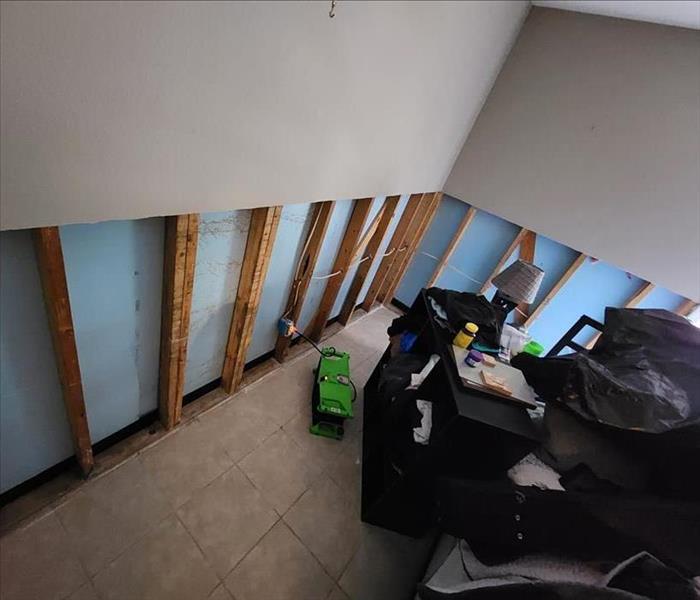 By avoiding these common mistakes and being proactive, you can protect your property from water damage disasters.
By avoiding these common mistakes and being proactive, you can protect your property from water damage disasters.
Water damage is a common and often expensive issue for homeowners, but many instances of water damage can be prevented with the right knowledge and precautions. Unfortunately, there are several common mistakes that homeowners make that can lead to water damage in their homes. By understanding these mistakes and taking proactive measures to address them, you can protect your home from potential water damage disasters. Here are some of the most common mistakes to avoid:
Neglecting Regular Maintenance
One of the most common mistakes homeowners make is neglecting regular maintenance tasks that can help prevent water damage. This includes failing to clean gutters and downspouts regularly, which can lead to clogs and water overflow during heavy rainfall. It also includes neglecting to inspect and maintain your plumbing system, such as checking for leaks, loose connections, or corrosion in pipes.
Ignoring Warning Signs
Ignoring warning signs of potential water damage can lead to larger issues down the road. Signs such as water stains on walls or ceilings, musty odors, peeling paint or wallpaper, or warped flooring should not be ignored. These could indicate hidden leaks, plumbing problems, or other issues that need to be addressed promptly to prevent further damage.
Improper Installation
Another common mistake is improper installation of appliances, fixtures, or plumbing systems. Poorly installed appliances like dishwashers, washing machines, or water heaters can leak or malfunction, leading to water damage over time. Similarly, improperly installed plumbing fixtures or connections can result in leaks or bursts that cause significant water damage to your home.
DIY Plumbing Repairs
Attempting DIY plumbing repairs without the necessary knowledge or experience can also lead to water damage. While it may be tempting to try to fix a leak or plumbing issue yourself to save money, improper repairs can worsen the problem and cause more extensive damage. It's best to leave plumbing repairs to qualified professionals who have the expertise and tools to do the job correctly.
Not Having Adequate Insurance Coverage
Finally, not having adequate insurance coverage can leave homeowners financially vulnerable in the event of water damage. It's essential to review your homeowner's insurance policy regularly and ensure that you have coverage for water damage caused by common sources such as burst pipes, plumbing leaks, or weather-related events. Consider adding optional coverage for specific types of water damage, such as sewer backup or flood insurance, depending on your location and risk factors.
By avoiding these common mistakes and taking proactive steps to prevent water damage in your home, you can protect your property and avoid the costly and stressful consequences of water damage disasters. Regular maintenance, prompt repairs, and proper insurance coverage are essential components of a comprehensive water damage prevention strategy. Remember that prevention is key when it comes to protecting your home from water damage, so take action today to protect your property for the future.
How To Prevent HVAC Water Damage
2/14/2024 (Permalink)
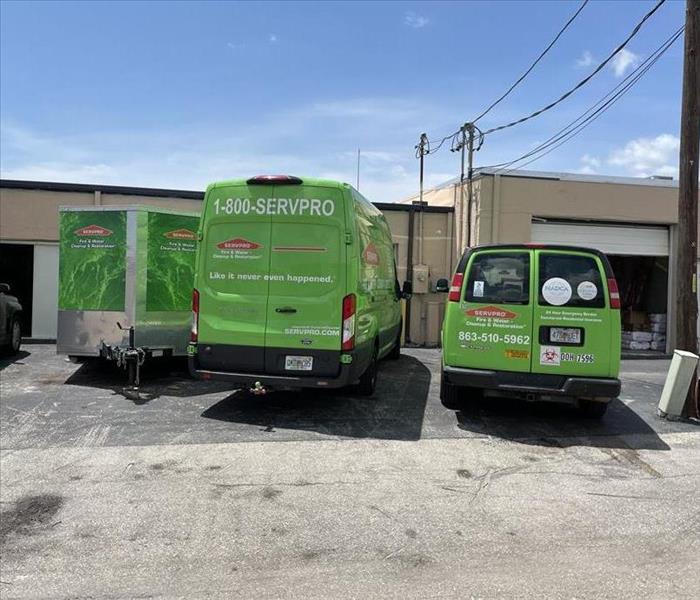 By partnering with professionals like SERVPRO, property owners can mitigate the risks associated with HVAC-related water damage.
By partnering with professionals like SERVPRO, property owners can mitigate the risks associated with HVAC-related water damage.
Heating, Ventilation, and Air Conditioning systems are integral to maintaining comfort in our homes or businesses. However, they can also be sources of potential water damage if not properly maintained. At SERVPRO®, we understand the importance of preventing HVAC-related water damage. In this article, we'll explore key strategies to protect your property from such incidents.
Regular Maintenance and Inspections
Consistent maintenance is crucial in preventing HVAC-related water damage. Schedule routine inspections by qualified professionals to check for leaks, condensation buildup, and clogged drains. Timely identification and repair of potential issues can prevent larger problems.
Change Filters Regularly
Dirty filters can cause HVAC systems to work inefficiently, leading to condensation buildup and potential water leaks. Change air filters regularly as recommended by manufacturers to maintain proper airflow and reduce the risk of water-related issues.
Keep Drain Lines Clear
Drain lines can become clogged over time, leading to water backup and potential overflows. Ensure drain lines are clear from debris or algae buildup by flushing them regularly. Consider adding algaecide tablets to prevent microbial growth.
Monitor Condensate Pans
Check condensate pans for standing water or debris accumulation. Overflowing or damaged pans can cause water to leak into surrounding areas. Regularly clean and maintain these pans to prevent potential leaks.
Inspect Insulation and Seals
Proper insulation around HVAC components and seals in ductwork is essential in preventing condensation and subsequent water damage. Inspect insulation for signs of wear or damage, and ensure seals are intact to prevent moisture intrusion.
Ensure Proper Slope and Drainage
Properly installed HVAC units should have adequate slope and drainage mechanisms to prevent water buildup. Ensure that units are installed correctly and that drainage is directed away from the property.
Install Leak Detection Devices
Consider installing water leak detection devices near HVAC systems. These devices can provide early alerts in case of leaks, allowing for timely intervention to prevent extensive damage.
Educate and Train Personnel
If you manage commercial properties, ensure that maintenance staff or personnel responsible for HVAC systems are trained to identify potential issues and understand preventive measures.
Why SERVPRO® for HVAC-Related Water Damage?
- Swift Response: Our 24/7 emergency service ensures immediate response to mitigate HVAC-related water damage, minimizing disruptions.
- Expertise: With specialized expertise in water damage restoration, our professionals deliver efficient solutions using advanced equipment.
- Preventive Strategies: We offer guidance on preventive measures to minimize the risk of HVAC-related water damage for both residential and commercial properties.
HVAC systems play a vital role in maintaining comfortable environments, but without proper maintenance, they can lead to water damage issues. By implementing these preventive strategies and partnering with professionals like SERVPRO of NE Hillsborough/Plant City, property owners can mitigate the risks associated with HVAC-related water damage.
How To Prepare Your Community Against Water-Related Disasters
10/9/2023 (Permalink)
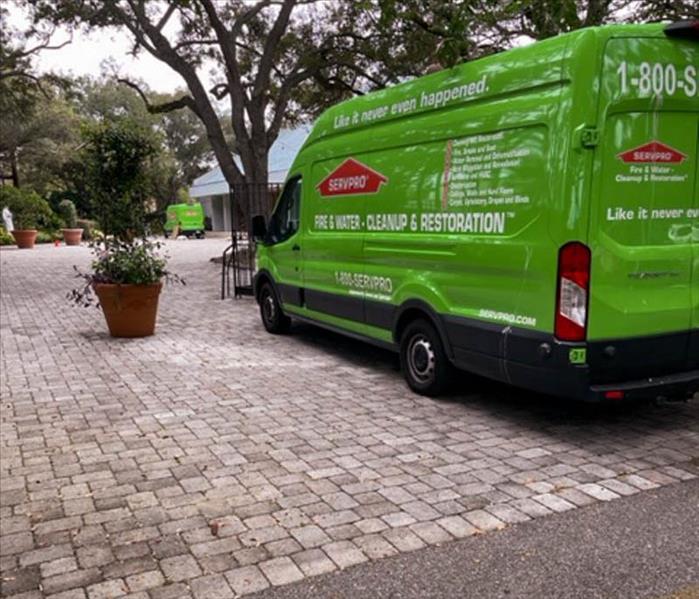 Community resilience against water-related disasters in Florida is not only a responsibility but a necessity.
Community resilience against water-related disasters in Florida is not only a responsibility but a necessity.
Florida, renowned for its picturesque coastlines and natural beauty, faces the recurring threat of water-related disasters. Hurricanes, flooding, and heavy rains often challenge our communities. To address these risks and foster resilience, it's essential for Florida residents to unite and take proactive measures. In this blog, we'll explore strategies and steps for bolstering community resilience against water-related disasters in the Sunshine State.
Community Preparedness Workshops
One of the initial steps in building resilience is educating the community. Organizing workshops that focus on preparedness can empower residents with knowledge about water-related disasters and the measures they can take to safeguard their homes and families. These workshops can cover topics such as hurricane preparedness, flood safety, and disaster response plans.
Emergency Response Planning
Communities should collaborate to formulate comprehensive emergency response plans. These plans must encompass evacuation routes, designated shelters, and effective communication strategies. Ensuring that every member of the community knows their role during a disaster can save lives and reduce panic.
Flood Preparedness and Mitigation
Flooding is a recurring threat in Florida, especially during hurricane season. Communities can invest in flood mitigation efforts such as improved drainage systems, elevation of vulnerable properties, and the creation of green spaces that can absorb excess water. Additionally, residents can take steps to protect their homes, like installing flood barriers and elevating utilities.
Storm-Resistant Building Practices
Florida's building codes have evolved to become some of the most stringent in the country, emphasizing hurricane-resistant construction. Encouraging and enforcing these codes ensures that new construction can withstand water-related disasters. Existing structures can also be retrofitted to improve their resilience.
Community Engagement and Support
Building resilience is a collective effort. Encourage neighbors to check in on each other, particularly vulnerable populations like the elderly and those with disabilities. Create community networks that can provide support during and after disasters. Knowing that you have a strong support system can alleviate stress during challenging times.
Professional Disaster Restoration Services
In the aftermath of a water-related disaster, it's essential to have access to professional disaster restoration services. Companies like SERVPRO® are well-equipped to handle water damage restoration, mold remediation, and more. Having a reliable restoration partner can expedite recovery efforts.
Community resilience against water-related disasters in Florida is not only a responsibility but a necessity. By educating ourselves, planning ahead, and working together, we can better protect our homes and loved ones. Remember, disasters can happen at any time, so it's essential to be prepared. If your community is affected by a water-related disaster, count on SERVPRO® to help you get back on your feet. We're here to support our fellow Floridians when they need it most.
Is a flooded basement covered with my insurance?
3/9/2023 (Permalink)
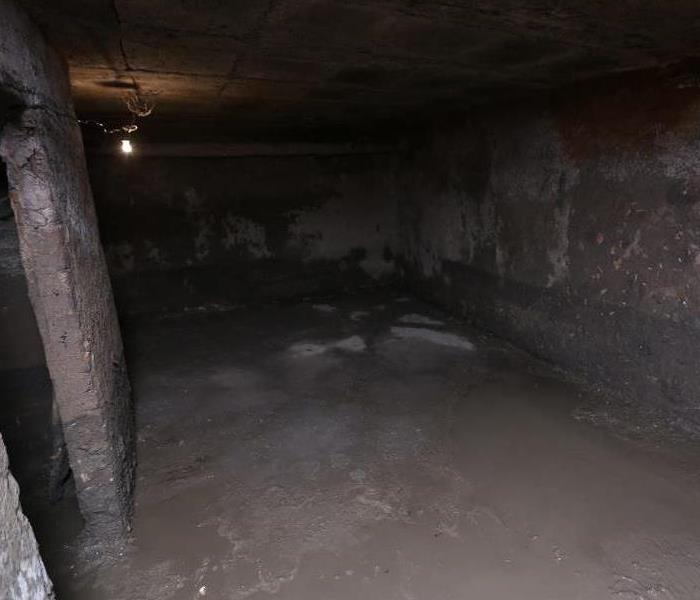 This flooded basement was caused from a recent storm.
This flooded basement was caused from a recent storm.
When it comes to home insurance, there are some things that you can't control. No matter how hard you try, things are going to go wrong sometime. And when they do, you'll want to know that your home is protected by a solid policy and that includes water damage coverage. But what if your basement floods? Is that covered? Do I need professional help? No matter how hard you try, things are going to go wrong sometime. It's just a fact of life.
What is Covered?
We all make mistakes and sometimes those mistakes lead to damage that affects our homes or businesses. But what about when water gets into the basement? Is it covered by insurance?
The short answer is yes, but it depends on your policy and what caused the flooding. If you have a standard homeowner's insurance policy, then most likely any damage from water would be covered as long as there wasn't any negligence involved in its entry into your home or business.
Water damage is the most common.
Water damage is the most common form of home insurance claim. The Insurance Information Institute reports that more than half of all homeowners' insurance claims are for water damage, which makes up about 50% of all insured losses.
Water damage can be caused by many things, including plumbing leaks or burst pipes, flooding from heavy rains or hurricanes/tropical storms, and even broken hoses that spray water onto your property. Water entering your home can happen inside as well as outside. A leaky roof or windowpane to cracks in the foundation caused by shifting soil below ground level (slap jacking).
It may not be covered by your policy.
It's important to check your policy to see if water damage is covered. If you have renters insurance or a home warranty, it may not cover your basement. If you live in a condo or co-op building and have purchased additional insured coverage for floods, this too might not apply when it comes to flooding in basements (since these are considered "common elements").
If you're unsure about what is covered by your policy and whether or not should purchase additional coverage for floods, talk with an agent.
You'll need a professional contractor.
If you have a flooded basement, your first step is to contact an experienced contractor. You need to trust that they will be able to get your home back in order and help you with any insurance claims that may arise from the damage.
You will also need patience. The process can be time consuming and frustrating, but if you're ready for it and willing, then everything will work out just fine. Just remember, there are no guarantees when dealing with insurance companies or contractors, so be prepared for anything!
How it works.
If you're dealing with a flooded basement, it's important to understand how your insurance policy covers the damage and what kind of help you can expect from your insurer. If there are other concerns beyond cost-effective repairs, like mold, then it might make sense for you to seek professional help from start-to-finish, otherwise, consider hiring someone who specializes in water damage restoration as soon as possible so that they can begin working on restoring order quickly and efficiently once everything dries out enough for them do so safely without risk of further damage occurring later down
As you can see, water damage is a common problem that can be difficult to deal with. It's important that you know what your insurance covers so that you can make sure your home stays safe and protected at all times. If you're unsure of what type of coverage or limits may apply in this situation, contact us today!
What Does Water Damage Look Like?
12/13/2022 (Permalink)
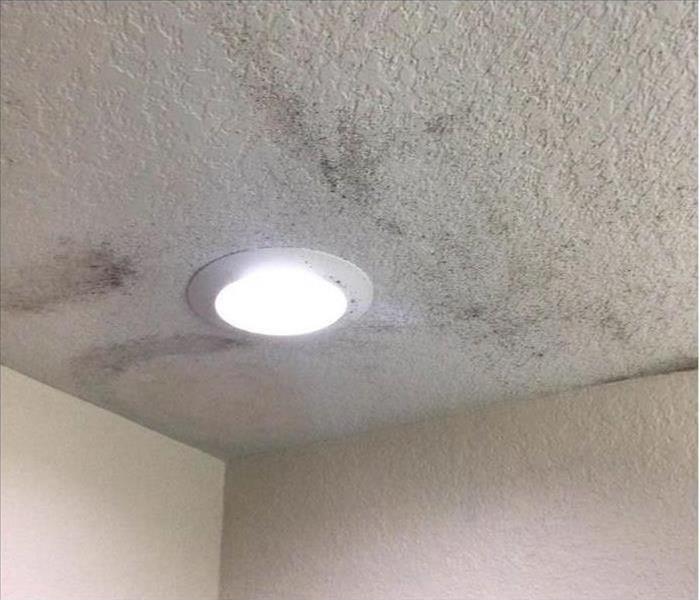 Water damage can lead to mold growth
Water damage can lead to mold growth
Signs of Water Damage
Water damage is something that can happen to anyone, but it can sometimes be difficult to tell when your home is affected. In addition to the obvious signs of a water damage that come from things like floods — such as watermarks on walls and floors or standing water in areas — there are several other indicators that may indicate hidden damage. We'll help you learn what these signs are and how they might affect your home so you can act before your property becomes irreparable.
Water can damage many things around the home.
Water damage can occur in many ways, including floods, broken pipes, and leaks. Water damage is also caused by a fire or even a faulty washing machine.
Water damage itself doesn't always look like water. When you notice a strange smell coming from an area of your home, it could be the result of water damage that you didn't know was there until it was too late. You may also see signs of mold growth on walls and ceilings as well as small stains or cracks in drywall where there wasn't any before.
Peeling, bubbling, or flaking paint
Paint is a form of plastic, so it can be damaged by water. Water damage to paint can also mean that there's been some other kind of damage to your home—because if the paint is peeling or bubbling up, you're probably looking at more than just a little bit of mold growing in the basement. The presence of water damage in your home (particularly on the walls) is likely an indication that there are problems with your foundation and/or plumbing system that need to be addressed by professionals.
Warped or discolored floorboards
If your wood floors have sustained water damage, you may notice that they've begun to warp or discolor. This can happen when the wood swells and shrinks due to the water damage. It can also happen when it cracks, which can cause it to lose its structural integrity. If you notice this type of damage in your home, hire a professional contractor as soon as possible.
Discoloration or texture changes in walls or ceilings
- Water damage can also cause discoloration or texture changes on walls and ceilings.
- In addition to wallpaper, water can damage paint, plaster, and the surface of drywall.
Swelling or buckling walls or floors
When a room is flooded, damaged walls and floors can swell or buckle. In some cases, the swelling may cause cracks in the drywall as well. This is because water collects inside these materials and expands over time to break them down. It's important to note that this type of damage can occur even if your home has no visible signs of flooding; if there are leaks or breaks in pipes that allow water into your home's interior, you could still be at risk for this sort of structural damage.
Rotting wood flooring
One of the first and most common signs of water damage is rotting wood flooring. When moisture seeps into a home’s floors, it can cause the wood underneath to rot and crumble away.
Not only because decaying floors can lead directly back towards health issues but also because rotten wood can become more flammable when it dries out.
Call SERVPRO
Water damage is a serious issue, one that can lead to mold growth and destruction of your property if not properly handled. If you think you may have water damage, call SERVPRO of NE Hillsborough/Plant City for help. We’re happy to come out and assess the situation at no charge. Call us today!
Water damage can be devastating to your home and belongings. The best thing to do is call a professional. You should never try to clean up the mess or fix the damage yourself, because it could cause more harm than good. Water is often not visible to the human eye, so if you spot signs of water damage it's important that you act quickly before additional damage occurs.
When Should I Change the Supply Lines In My Bathroom?
11/5/2022 (Permalink)
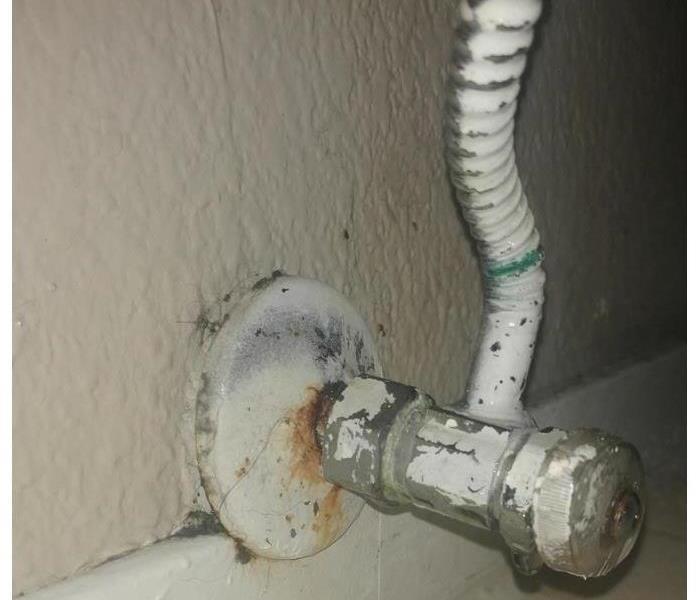 You should change the supply lines in your bathroom every few years.
You should change the supply lines in your bathroom every few years.
When Should I Change the Supply Lines in my Bathroom?
If you're like most people, your bathroom supply lines are one of the least-talked about components of your home. Even though they're out of sight, they're not out of mind! In fact, these plumbing parts are used every day and can be susceptible to leaks as they age over time. Knowing when to replace them can help save you from a lot of headache and money down the road — so let's get started!
The supply lines in your bathroom connect to the main water line and delivers water directly to your faucets. Supply lines are usually located behind the walls or under the sink, but they can also be found inside of a wall or floor.
The materials used to make supply lines vary depending on how they will be used and where they are in your home. Plastic supply lines are typically used inside of walls, while copper or galvanized steel supply lines are often found running from a water meter to a house's exterior.
Supply lines are one of the most neglected components of your bathroom since they're typically located behind the walls or under the sink.
You should still clean and inspect these lines regularly to make sure they remain in good condition. If you notice any signs of wear or damage, you'll want to replace them before there is a leak. This will prevent water damage from flooding parts of your home as well as prevent potential health risks that can come with prolonged exposure to mold and mildew buildup on your supply lines.
Supply lines are used multiple times a day and contain rubber parts that deteriorate over time due to constant exposure to pressurized water temperature changes and chemicals.
You should change the supply lines in your bathroom every few years because they are used every day, multiple times a day and contain rubber parts that deteriorate over time due to constant exposure to pressurized water temperature changes and chemicals. You can prolong the life of your supply lines by installing plastic shut-off valves near each faucet (including tub spouts), installing an anti-scald device at the hot water heater, and keeping cabinet doors closed when not in use.
Leaking supply lines can cause significant damage, so it's important that you understand when they need to be replaced.
When should I replace the supply lines in my bathroom?
- Replace the supply lines in your bathroom as soon as you observe any sign of leaking. Leaking can be caused by several factors, but one thing's for sure: it will lead to significant damage if left unchecked.
- Plastic supply lines are often covered under a 5–8-year warranty, but steel braided ones come with lifetime warranties. Not only that, but they're also less likely to leak than plastic ones—and they look nicer too!
Supply lines should be replaced every 5-8 years or immediately if leaking
If you're like most of us, you use the water in your bathroom every day. You might take a shower or have a bath. Maybe you wash your hands or brush your teeth. You probably drink from the faucet and clean with soap dispensers and liquid hand soaps.
Whatever it is that you do in there, there's no question that demand on the supply lines (the pipes) is very high. The problem is that they contain rubber parts that deteriorate over time—and sometimes fast. If they begin to leak while they still look good, this isn't necessarily an indicator that they need replacing because they may just be going bad prematurely due to age and wear-and-tear factors such as temperature fluctuations or regular use.
Hopefully, this article has been helpful in demystifying the supply line replacement process. There’s no need to be intimidated by it; just follow the guidelines above and you'll be sure to get the job done right.
3 Things You Need To Know To Fix a Leaky Faucet
4/16/2022 (Permalink)
3 Things You Should Know About Fixing A Leaky Faucet
A leaking faucet can be annoying and over time can make your water bill higher than it should be. Instead of calling a plumber to fix your dripping faucet in Plant City, FL, here are a few tips to help you save money and do it yourself.
1. Figure Out What Type of Faucet You have
There are four common types of faucets. You must know which type you have before you can fix a leaking faucet, as each one has different parts. A compression faucet is the most recognizable, with two separate handles for hot and cold water. The other three types (cartridge faucet, ball faucet, and ceramic-disk faucet) aren't as easy to tell apart just by looking at them, and you'll likely need to take them apart first to determine what's inside.
2. Determine What Tools You Need
No matter which type of faucet you have, you'll need a few standard tools to get the job done, including a Phillips-head screwdriver, a flat-head screwdriver, wrench, pliers, and plumber's grease (make sure it's nontoxic and heat-resistant). If you have a ball faucet, it requires other special parts and tools that can be purchased as a kit at most home repair stores.
3. Purchase Replacement Parts if Needed
To fix a compression-style leaking faucet, replacement seat washers are required. A cartridge faucet needs replacement O-rings. If you have a ball faucet, a ball-faucet replacement kit is necessary. For a ceramic-disk faucet, you may have to purchase replacement seals and vinegar for cleaning the parts.
Once you have a fixed leak, you can be at ease knowing you saved money and avoided additional water damage restoration costs, if that leaky faucet had turned into something more serious. You're also prepared and know what to do if it happens again, such as having the right tools and an extra replacement kit on hand.
3 Tips for Checking for Leaks in Your Bathroom
3/1/2022 (Permalink)
Three Ways To Check Your Bathroom For Leaks
If your Plant City, FL, has experienced a bathtub leak you may be wondering how to locate any other leaks that could occur in your bathroom. Fortunately, many water damage professionals recommend looking at a few key areas. These include
1. Checking the Drain Area
In some cases, if you have a shower pan leak, checking the drain area may give you some indications. In many cases, the first signs of a leak may show up around the drain and related pipes. This includes crawl spaces or behind walls where the pipes from the drains may be routed. A plumbing professional may be able to tell you some other signs you should be looking for.
2. Checking the Room Below the Bathroom
If you've experienced a bathtub leak then you may want to check the room below the tub to see if you can find any signs of water damage coming from above. This may include discoloration of the ceiling, soggy or peeling paint, or signs of dampness on the floor below where water could have dripped. In the event you find water damage, then you may want to contact a water damaged professional to take care of any repairs.
3. Checking for Wear and Tear
It's important to look for signs of wear and tear whenever inspecting your bathroom for possible leaks. Look for spaces of loose grout, peeling caulking, chipped tile or concrete, and for other general signs of frequent use. If you know the age of your bathroom fixtures, then you may be able to find other recommendations of things to look for from the manufacturer.
Whether you have a bathtub leak, a shower drain problem, or an issue with the bathroom sink, looking at these things may help you find a leak before it causes water damage. If you do find water damage or a plumbing problem, it's best to contact a professional as soon as possible.
How To Find the Source of a Toilet Leak
2/1/2022 (Permalink)
How To Figure Out Where A Toilet Leak Is Coming From
A toilet is a simple machine that homeowners in Valrico, FL, often take for granted. When you have a leaking toilet, however, you may become acutely aware of how disruptive this dysfunction may be to your daily life. Fortunately, it's pretty easy to discover where the leak originates and thus the next steps to fixing it.
Possible Causes
A bathroom leak is not something you want to ignore. It only takes a small amount of water to cause damage such as rot or mold under your floor tiles. If you notice water at the base of the toilet when you flush, it could have several causes:
- Wax seal failure
- Improper installation of seal
- Faulty supply line
- Cracked tank
- Condensation on bowl
To determine which of these issues is causing the leak, dry off the area with a towel. Flush the leaking toilet again, and pay attention to where the water comes from. If it leaks out the bottom, you know the problem is with the way the toilet is fastened or sealed. If it leaks from the hose running from the wall or from the tank, you know the problem stems from that particular area.
Possible Solutions
When water is leaking from somewhere other than the base of the toilet, call a plumber to repair the source of the leak and water restoration specialists to assess and repair the damage it may have caused. You may be able to stop water from leaking at the base by simple tightening the bolts that secure it to the floor. If that doesn't fix it, you may need to remove the toilet and replace the wax seal to stop the leak.
A leaking toilet can throw off your day. Once you locate the problem, however, the solution may be fairly simple. Troubleshoot what you can, and call in the experts if the problem is too big or you need water damage remediation.
3 Tips for Checking for Leaks in Your Bathroom
1/26/2022 (Permalink)
Three Ways To Check Your Bathroom For Leaks
If your Plant City, FL, has experienced a bathtub leak you may be wondering how to locate any other leaks that could occur in your bathroom. Fortunately, many water damage professionals recommend looking at a few key areas. These include
1. Checking the Drain Area
In some cases, if you have a shower pan leak, checking the drain area may give you some indications. In many cases, the first signs of a leak may show up around the drain and related pipes. This includes crawl spaces or behind walls where the pipes from the drains may be routed. A plumbing professional may be able to tell you some other signs you should be looking for.
2. Checking the Room Below the Bathroom
If you've experienced a bathtub leak then you may want to check the room below the tub to see if you can find any signs of water damage coming from above. This may include discoloration of the ceiling, soggy or peeling paint, or signs of dampness on the floor below where water could have dripped. In the event you find water damage, then you may want to contact a water damaged professional to take care of any repairs.
3. Checking for Wear and Tear
It's important to look for signs of wear and tear whenever inspecting your bathroom for possible leaks. Look for spaces of loose grout, peeling caulking, chipped tile or concrete, and for other general signs of frequent use. If you know the age of your bathroom fixtures, then you may be able to find other recommendations of things to look for from the manufacturer.
Whether you have a bathtub leak, a shower drain problem, or an issue with the bathroom sink, looking at these things may help you find a leak before it causes water damage. If you do find water damage or a plumbing problem, it's best to contact a professional as soon as possible.
Protecting Your Home Against Water Damage
1/5/2022 (Permalink)
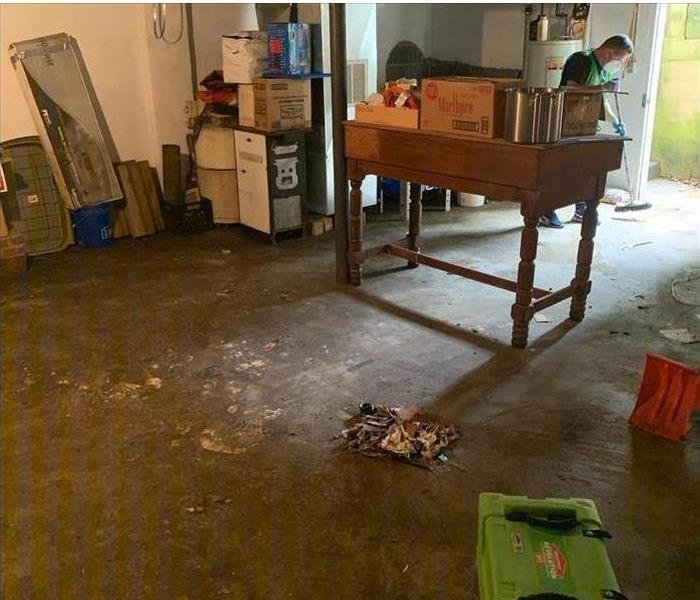 This basement was flooded and SERVPRO was able to remove all the water and clean up the mess!
This basement was flooded and SERVPRO was able to remove all the water and clean up the mess!
Defending Your Home From Water Damage
Never assume your household in Plant City, FL, is completely safe from flooding just because it’s dry outside. Learn how to protect against problematic water in home areas by following a few simple precautions.
1. Airflow
Surprisingly, the water lines used by your central heating and air systems can be a significant and costly source of leaks. If any water buildup occurs besides a small amount of condensation, have the unit inspected by an HVAC professional. A substantial drip or leak from any pipe leading to or from the unit will cause moisture to accrue in the surrounding area. Also ensure that the home temperatures are set within reasonable margins to prevent the unit from freezing, which can lead to a damaged or broken pipe.
2. Plumbing
Plumbing and drainage systems can be another source of excess water in home surfaces. Make sure that your toilet tank has no dripping water. Inspect the ring seal around the base of your toilet so that water can move from the bowl to the sewer without accumulating in the flooring. Check other pipes for cracks, especially at bends and connection points. If the damage is significant, some types of pipe cleanup and other water damage restoration may be best left to a professional service.
3. Your Policy
While many robust home insurance policies are available, no insurer will cover every possible flood damage scenario. This is especially true in cases of negligence, such as when a home is unoccupied for a long period of time or when a flooding problem goes unaddressed and causes ongoing damage. Stay on top of inspection and maintenance tasks to guarantee that you remain within the bounds of your existing coverage.
No homeowner wants to incur costly repair and replacement fees by ignoring flood water in home areas. By checking on the condition of your pipes and stopping leaks when they occur, you can keep your home dry for years to come.
 Here are key strategies to protect your property from water intrusion and ensure it remains safe and dry year-round.
Here are key strategies to protect your property from water intrusion and ensure it remains safe and dry year-round.



 24/7 Emergency Service
24/7 Emergency Service





